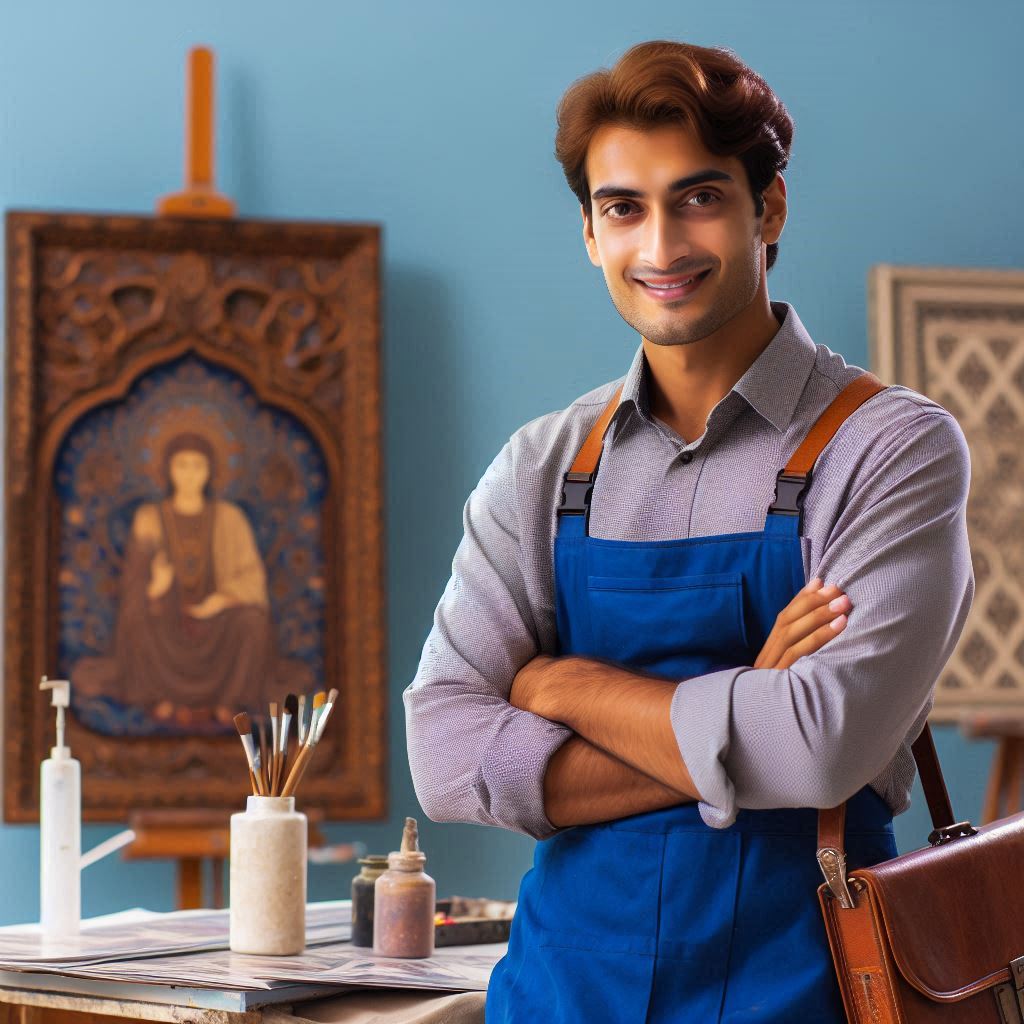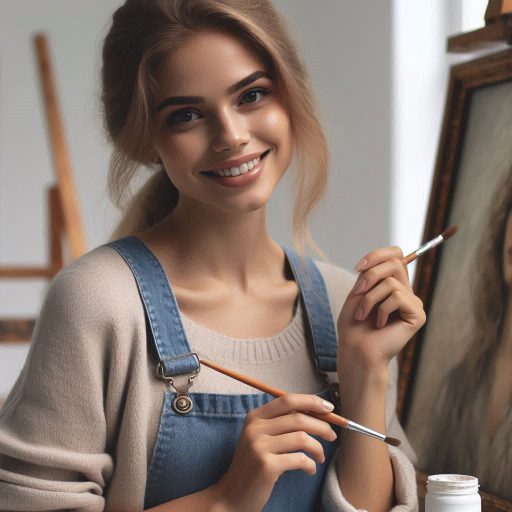Introduction
Art conservators/restorers play a vital role in preserving cultural heritage.
They are responsible for the repair, restoration, and preservation of artworks.
Art conservation/restoration is crucial in maintaining the integrity and longevity of historical artifacts and masterpieces.
Steps to Becoming an Art Conservator/Restorer
- Educational Background: Obtain a bachelor’s degree in art history, fine arts, chemistry, or related field.
- Specialized Training: Pursue a master’s degree in art conservation or related programs.
- Internship/Apprenticeship: Gain hands-on experience by working under experienced conservators/restorers.
- Build a Portfolio: Showcase your skills through completed conservation projects and research work.
- Continuing Education: Stay updated on new techniques, materials, and conservation practices through workshops and seminars.
- Network: Build connections with professionals in the field to learn about job opportunities and collaborations.
- Gain Certification: Consider pursuing certification from organizations like the American Institute for Conservation.
- Job Search: Look for positions at museums, galleries, conservation labs, or private practices to kickstart your career.
By following these steps diligently, you can pave your way towards a successful career as an art conservator/restorer.
Education and Training
Bachelor’s Degree in Art History or a Related Field
Earning a bachelor’s degree in art history or a related field is the first step towards becoming an art conservator.
These programs provide a strong foundation in art theory, history, and context.
Coursework typically includes art appreciation, art criticism, and the study of different art movements and styles.
Additionally, students may have the opportunity to take hands-on art classes to develop their artistic skills.
It is crucial to maintain a high GPA throughout your undergraduate studies to ensure acceptance into a reputable master’s program in conservation.
Master’s Degree in Conservation or a Specialized Program
After completing a bachelor’s degree, aspiring art conservators should pursue a master’s degree in conservation or a specialized art conservation program.
These programs provide in-depth knowledge and training in the restoration and preservation of artworks.
Students learn about the science behind art materials, techniques for cleaning and restoring artwork, and ethical considerations in conservation.
It is essential to choose a program accredited by the American Institute for Conservation (AIC) to ensure that you receive a high-quality education that meets industry standards.
Gain Hands-On Experience Through Internships or Volunteering
Hands-on experience is crucial for aspiring art conservators to develop practical skills and build a portfolio of work.
Internships and volunteer opportunities at museums, galleries, or conservation labs provide valuable experience in working with different types of artwork.
During these experiences, individuals learn about the day-to-day responsibilities of an art conservator, including documentation, examination, treatment, and storage of artworks.
Additionally, they have the chance to work alongside experienced professionals and gain insight into the field.
Building a network of contacts in the art conservation community is also beneficial for securing future employment opportunities and collaborating on projects.
Overall, obtaining a bachelor’s degree, pursuing a master’s degree, and gaining hands-on experience through internships or volunteering are essential steps to becoming a successful art conservator.
By investing in education and training, individuals can develop the skills and knowledge needed to preserve and protect cultural heritage for future generations.
Transform Your Career Today
Unlock a personalized career strategy that drives real results. Get tailored advice and a roadmap designed just for you.
Start NowRead: Top Fashion Styling Courses and Certifications
Develop Technical Skills
In order to become an art conservator/restorer, it is essential to develop strong technical skills that will enable you to effectively preserve and restore valuable artworks.
Techniques for Cleaning, Repairing, and Preserving Artworks
- Learn various techniques for cleaning delicate paintings, sculptures, and other art pieces.
- Understand the process of repairing damages such as tears, cracks, and discoloration in artworks.
- Master the skills needed to properly preserve art pieces to prevent further deterioration.
Familiarize Yourself with Different Types of Art Materials
- Study the properties of various art materials such as oil paints, canvas, wood, and ceramics.
- Learn about the specific conservation requirements for different types of materials to ensure proper restoration.
- Understand how environmental factors can impact the longevity of different art materials.
Practice Using Specialized Tools and Equipment
- Get hands-on experience with specialized tools like brushes, scalpels, microscopes, and solvents.
- Learn how to use advanced equipment such as UV lights, humidity controls, and temperature monitors.
- Practice using these tools and equipment under the guidance of experienced conservators to hone your skills.
By developing these technical skills, you will be better equipped to handle the intricate process of art conservation and restoration.
Remember that practice and dedication are key to mastering these skills and becoming a successful art conservator/restorer.
Read: Key Differences Between Fashion Stylist and Designer
Specialize in a Medium
When pursuing a career as an art conservator/restorer, it is crucial to specialize in a particular medium.
This allows you to develop in-depth knowledge and skills in that specific area.
Here are some steps to help you specialize:
Choose a Specific Type of Art
Start by selecting a specific type of art to specialize in, such as paintings, sculptures, or textiles.
Consider your interests, strengths, and the availability of opportunities in the field.
Attend Workshops or Courses
Once you have decided on your chosen medium, seek out workshops or courses that focus on the conservation and restoration of that particular type of art.
These educational opportunities will provide you with valuable hands-on experience and specialized training.
Build a Portfolio
It is essential to build a portfolio showcasing your expertise in the chosen medium.
Include before-and-after examples of your conservation/restoration work, as well as any research or projects related to the specific type of art you specialize in.
This portfolio will demonstrate your skills and capabilities to potential employers or clients.
By following these steps and specializing in a specific medium, you can set yourself apart as an art conservator/restorer and establish yourself as an expert in the field.
Read: How to Start Your Journey as a Fashion Stylist Today

Build a Professional Network
Building a professional network is indispensable in the art conservation field.
Here are some essential steps:
Attend Conferences, Workshops, and Other Events
Engaging in these events allows you to stay updated on the latest trends and techniques in art conservation.
Transform Your Career Today
Unlock a personalized career strategy that drives real results. Get tailored advice and a roadmap designed just for you.
Start NowIt also provides the opportunity to network with professionals in the field.
Join Professional Organizations
Membership in organizations such as the American Institute for Conservation (AIC) or the International Institute for Conservation (IIC) is crucial.
These organizations offer resources, training, and networking opportunities.
Connect with Experienced Art Conservators/Restorers
Establishing relationships with seasoned professionals can be incredibly beneficial.
They can provide valuable mentorship, advice, and insights into the industry.
Overall, building a strong professional network is key to advancing your career in art conservation.
It opens doors to new opportunities, enhances your knowledge and skills, and connects you with like-minded individuals in the field.
Read: Case Studies in Art Conservation and Restoration
Obtain Certification
Once you have gained the necessary education and experience, the next step towards becoming an art conservator/restorer is to obtain certification.
Pursue Certification
- Seek certification from reputable organizations such as the AIC or the Institute of Conservation (ICON).
- Research the requirements for certification and ensure you meet all eligibility criteria.
Complete Required Exams or Training Programs
- Prepare for and complete any exams or training programs needed for certification.
- These exams will test your knowledge and skills in art conservation and restoration.
Maintain Your Certification
- Stay current with industry standards and best practices to maintain your certification status.
- Participate in continuing education programs and workshops to enhance your skills.
By obtaining certification, you demonstrate your commitment to professionalism and excellence in the field of art conservation and restoration.
It also provides credibility to your expertise and skills, which can be valuable when seeking employment or working with clients.
Gain More Insights: Top Lighting Design Software for Professionals
Discover More: The Future of Typography: Trends to Watch
Gain Work Experience
After completing your formal education and obtaining certifications, the next step to becoming an art conservator/restorer is to gain work experience.
This crucial step will allow you to apply your knowledge in a practical setting and develop your skills further.
Here are some essential strategies to help you gain valuable work experience in the field:
Apply for Positions
Seek out job opportunities at museums, conservation labs, or private practices that specialize in art restoration and conservation.
Look for positions that align with your interests and qualifications.
Submit your resume, cover letter, and portfolio showcasing your skills and previous work experience.
Participate in Conservation Projects
One effective way to gain hands-on experience is by participating in conservation projects.
Transform Your Career Today
Unlock a personalized career strategy that drives real results. Get tailored advice and a roadmap designed just for you.
Start NowReach out to conservation organizations, museums, or galleries that work on restoring and preserving artworks.
By getting involved in these projects, you will have the opportunity to work directly with real artworks under the guidance of experienced professionals.
Collaborate with Other Professionals
Networking and collaborating with other professionals in the field can help you expand your knowledge and skills.
Attend conferences, workshops, and seminars to connect with art conservators, restorers, and experts in the industry.
By building relationships and exchanging ideas with fellow professionals, you can learn new techniques, approaches, and best practices in art conservation and restoration.
Seek Mentorship Opportunities
Consider seeking mentorship from experienced art conservators or restorers who can provide guidance and support as you navigate your career path.
A mentor can offer valuable insights, advice, and feedback on your work, helping you improve your skills and develop professionally.
Look for opportunities to shadow experienced professionals, assist them on projects, and learn from their expertise.
Continue Learning and Growing
Stay updated on the latest advancements, research, and techniques in art conservation and restoration.
Take continuing education courses, attend training programs, and pursue certifications to enhance your skills and expertise.
Stay curious, proactive, and dedicated to lifelong learning to excel in the field of art conservation and restoration.
Contribute to the Field
As you gain experience and expertise in art conservation and restoration, consider contributing to the field through research, publications, and presentations.
Share your knowledge, insights, and findings with the broader art conservation community to advance the profession.
By actively participating in the field and contributing to its growth, you can establish yourself as a respected and skilled art conservator/restorer.
In general, gaining work experience is a crucial step in becoming a successful art conservator/restorer.
By applying for positions, participating in conservation projects, collaborating with other professionals, seeking mentorship, continuing to learn and grow, and contributing to the field, you can develop your skills, expand your knowledge, and establish yourself in the competitive field of art conservation and restoration.
Stay Updated on New Technologies
Keep abreast of advancements in art conservation technology
As an art conservator/restorer, it is crucial to stay updated on new technologies that can greatly impact your work.
By staying informed about the latest advancements in art conservation technology, you can enhance the quality of your restoration projects and ensure that you are using the most effective methods available.
Attend workshops or training sessions on the latest conservation methods and tools
Attending workshops or training sessions on the latest conservation methods and tools is a great way to learn about new techniques and stay current in the field.
These opportunities provide hands-on experience and the chance to network with other professionals in the industry.
Transform Your Career Today
Unlock a personalized career strategy that drives real results. Get tailored advice and a roadmap designed just for you.
Start NowIncorporate new techniques into your practice to enhance your conservation/restoration work
By incorporating new techniques into your practice, you can improve the outcomes of your conservation and restoration work.
Experimenting with different methods and tools can help you achieve better results and ensure that you are providing the best possible care for art pieces in your care.
Overall, staying updated on new technologies is essential for art conservators/restorers who want to continue improving their skills and offering top-notch services to clients.
Embracing advancements in the field can set you apart as a knowledgeable and skilled professional in the art conservation industry.
You Might Also Like: Trends in Modern Production Design
Conclusion
Becoming an art conservator/restorer involves completing a relevant academic program in conservation or art history.
It is crucial to gain practical experience through internships and hands-on training in conservation labs.
Building a strong network and staying updated on the latest conservation techniques are essential for professional development in this field.
Aspiring art conservators/restorers should nurture their passion for preserving cultural heritage through conservation by seeking opportunities to contribute to the field.
Lifelong learning and continuous professional development are key to staying competitive and making a meaningful impact in the conservation community.
By following these steps and being dedicated to their craft, individuals can embark on a fulfilling career as an art conservator/restorer.
[E-Books for Sale]
The Big Book of 500 High-Paying Jobs in America: Unlock Your Earning Potential
$19.99 • 500 High-Paying Jobs • 330 pages
Explore 500 high-paying jobs in America and learn how to boost your career, earn more, and achieve success!
See All 500 High-Paying Jobs of this E-Book
1001 Professions Without a Degree: High-Paying American Jobs You Can Start Now
$19.99 • 1001 Professions Without a Degree • 174 pages
Discover 1001 high-paying jobs without a degree! Unlock career tips, skills, and success strategies for just $19.99!




